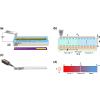当前位置:
X-MOL 学术
›
Phys. Rev. Appl.
›
论文详情
Our official English website, www.x-mol.net, welcomes your
feedback! (Note: you will need to create a separate account there.)
Modeling the Motion of Ferroelectric Domain Walls with the Classical Stefan Problem
Physical Review Applied ( IF 3.8 ) Pub Date : 2020-01-06 , DOI: 10.1103/physrevapplied.13.014006 P. V. Yudin , M. Yu. Hrebtov , A. Dejneka , L. J. McGilly
Physical Review Applied ( IF 3.8 ) Pub Date : 2020-01-06 , DOI: 10.1103/physrevapplied.13.014006 P. V. Yudin , M. Yu. Hrebtov , A. Dejneka , L. J. McGilly

|
With advances in nanotechnology, ferroelectric switching by individual domain walls (DWs) has become a subject of broad interest. Conventional models consider DW motion in a fixed homogeneous or inhomogeneous electric field. However, it is clear that the electric field commonly evolves in time due to the redistribution of bound charges and screening free charges on the ferroelectric surface, particularly due to surface conductance. Taking this effect into account remains a serious challenge. Here we propose a simple concept to describe simultaneously the evolution of the electric field and the DW motion in a ferroelectric sample. The approach is based on a full analogy between charge transport during ferroelectric switching and heat transport in a moving melting front: the classical Stefan problem. The analogy helps in the establishment of control of DW motion in thin films. Experimentally, DWs are displaced by voltage pulses under electrodes with a limited conductivity and detected using piezoresponse force microscopy. In the frame of a combined theoretical and experimental approach, DW-friction mechanisms and the impact of the DW energy on its shape are discussed. The study facilitates the development of nanoelectronic devices.
中文翻译:

用经典Stefan问题模拟铁电畴壁的运动
随着纳米技术的进步,通过单个畴壁(DW)进行铁电开关已成为人们广泛关注的主题。常规模型考虑在固定的均匀或不均匀电场中的DW运动。但是,很明显,电场通常是由于束缚电荷的重新分布和屏蔽铁电表面上的自由电荷(特别是由于表面电导)而随时间变化的。考虑到这种影响仍然是一个严峻的挑战。在这里,我们提出了一个简单的概念来同时描述铁电样品中电场和DW运动的演化。该方法基于铁电切换过程中的电荷传输与移动熔化前沿中的热传输之间的完全类比:经典的Stefan问题。该类比有助于建立薄膜中DW运动的控制。实验上,DW被电极下方的电压脉冲以有限的电导率置换,并使用压电响应力显微镜进行检测。在理论和实验相结合的框架下,讨论了DW摩擦机理以及DW能量对其形状的影响。该研究促进了纳米电子器件的发展。
更新日期:2020-01-07
中文翻译:

用经典Stefan问题模拟铁电畴壁的运动
随着纳米技术的进步,通过单个畴壁(DW)进行铁电开关已成为人们广泛关注的主题。常规模型考虑在固定的均匀或不均匀电场中的DW运动。但是,很明显,电场通常是由于束缚电荷的重新分布和屏蔽铁电表面上的自由电荷(特别是由于表面电导)而随时间变化的。考虑到这种影响仍然是一个严峻的挑战。在这里,我们提出了一个简单的概念来同时描述铁电样品中电场和DW运动的演化。该方法基于铁电切换过程中的电荷传输与移动熔化前沿中的热传输之间的完全类比:经典的Stefan问题。该类比有助于建立薄膜中DW运动的控制。实验上,DW被电极下方的电压脉冲以有限的电导率置换,并使用压电响应力显微镜进行检测。在理论和实验相结合的框架下,讨论了DW摩擦机理以及DW能量对其形状的影响。该研究促进了纳米电子器件的发展。











































 京公网安备 11010802027423号
京公网安备 11010802027423号